A short view of land restoration in the central Texas hill country. Restoration there turned an overgrazed, dry, and dusty ranch into a forest with lakes, fresh springs, and wildlife.
Jump to: Films | Podcasts | Articles | Books | Lessons
Films
50 Years Ago, This Was A Wasteland
Categories: Ecology, Humans & Nature, Short Films
The Man Who Planted Trees (1987)
Categories: Culture, Ecology, Humans & Nature, Top Picks
The Man who Planted Trees is an award-winning animated short film based on a short story by the same title. In brief, the film tells the story of a shepherd—Elzéard Bouffier’s—attempt to re-forest an entire French valley alone, becoming acquainted with values of love, compassion and peace that the practice brings him through the years. Accompanied by whimsical illustrations and a touching storyline, this film highlights the tranquility and compassion that often get overshadowed in stories of modern-day environmentalism.
How Wolves Change Rivers: Interconnectedness in Nature
Categories: Ecology, Short Films
As we begin to understand the interconnectedness of the modern world, the ecosystem of the Northern Rockies in the United States has been one of our primary sources of learning. The grey wolf was exterminated there in the early 1900’s and the ecosystem began to fall apart ever since. All life suffered: from the largest elk and grizzly bears, to the insects, fish, and grasses, in what is termed a “trophic cascade.” When wolves were reintroduced in 1995, that change reversed in just a matter of years. The film asks: “how do wolves change rivers?” reminding us of the inextricable connection between species in nature.
180° South: Conquerors of the Useless
Categories: Culture, Ecology, Humans & Nature
This documentary is the quintessential adventure classic. Splitting time between wild places and the developing world of South America, this film delves into the mindset of living for the journey, not the destination. Along the way, the hero explores sustainability in the developing world, collapse of past civilizations, and some of the largest and most innovative conservation efforts on the continent.
Articles
How Long Before These Salmon Are Gone? ‘Maybe 20 Years’
Categories: Climate Change, Ecology
Some 45,000 to 50,000 spring-summer Chinook spawned here in the 1950s. These days, the average is about 1,500 fish, and declining. And not just here: Native fish are in free-fall throughout the Columbia River basin, a situation so dire that many groups are urging the removal of four large dams to keep the fish from being lost.
The Crisis for Birds Is a Crisis for Us All
Categories: Climate Change, Ecology
Nearly one-third of the wild birds in the United States and Canada have vanished since 1970, a staggering loss that suggests the very fabric of North America’s ecosystem is unraveling.
The disappearance of 2.9 billion birds over the past nearly 50 years was reported today in the journal Science, a result of a comprehensive study by a team of scientists from seven research institutions in the United States and Canada.
Soil as Carbon Storehouse: New Weapon in Climate Fight?
Categories: Climate Change, Ecology, Humans & Nature
The damage or disappearance of ecologies and plant cover have caused significant soil degradation, which, it turns out, has released much CO2 into the atmosphere. In fact, the world’s cultivated soils have lost between 50 and 70 percent of their original carbon stock, according to recent research, much of which has oxidized upon exposure to air to become CO2. But new research is finding ways to recapture CO2 through land restoration.
“Recognition of the vital role played by soil carbon could mark an important if subtle shift in the discussion about global warming, which has been heavily focused on curbing emissions of fossil fuels. But a look at soil brings a sharper focus on potential carbon sinks. Reducing emissions is crucial, but soil carbon sequestration needs to be part of the picture as well, says Lal. The top priorities, he says, are restoring degraded and eroded lands, as well as avoiding deforestation and the farming of peatlands, which are a major reservoir of carbon and are easily decomposed upon drainage and cultivation.
Goreau says we need to seek opportunities to increase soil carbon in all ecosystems — from tropical forests to pasture to wetlands — by replanting degraded areas, increased mulching of biomass instead of burning, large-scale use of biochar, improved pasture management, effective erosion control, and restoration of mangroves, salt marshes, and sea grasses.
Scientists say that more carbon resides in soil than in the atmosphere and all plant life combined; there are 2,500 billion tons of carbon in soil, compared with 800 billion tons in the atmosphere and 560 billion tons in plant and animal life. And compared to many proposed geoengineering fixes, storing carbon in soil is simple: It’s a matter of returning carbon where it belongs.”
Environmentalism as Religion
Categories: Climate Change, Ecology, Humans & Nature
In this article, Joel Garreau explores the idea that environmentalism has become the new religion of choice for urban atheists, overtaking the traditional place of socialism for them.
In a widely quoted 2003 speech, Crichton outlined the ways that environmentalism “remaps” Judeo-Christian beliefs:
“There’s an initial Eden, a paradise, a state of grace and unity with nature, there’s a fall from grace into a state of pollution as a result of eating from the tree of knowledge, and as a result of our actions there is a judgment day coming for us all. We are all energy sinners, doomed to die, unless we seek salvation, which is now called sustainability. Sustainability is salvation in the church of the environment. Just as organic food is its communion, that pesticide-free wafer that the right people with the right beliefs, imbibe.”
According to Garreau, environmentalism has: 1) merged with Eastern-based spiritualism and concepts lifted from Hinduism, Daoism, or Buddhism; 2) harked back to pagan and animist traditional (pre-scientific) beliefs; and 3) and started a “greening” process of Judeo-Christian theology.
Freeman Dyson, the brilliant and contrarian octogenarian physicist, agrees. In a 2008 essay in the New York Review of Books, he described environmentalism as “a worldwide secular religion” that has “replaced socialism as the leading secular religion.” This religion holds “that we are stewards of the earth, that despoiling the planet with waste products of our luxurious living is a sin, and that the path of righteousness is to live as frugally as possible.” The ethics of this new religion, he continued,
“are being taught to children in kindergartens, schools, and colleges all over the world…. And the ethics of environmentalism are fundamentally sound. Scientists and economists can agree with Buddhist monks and Christian activists that ruthless destruction of natural habitats is evil and careful preservation of birds and butterflies is good. The worldwide community of environmentalists — most of whom are not scientists — holds the moral high ground, and is guiding human societies toward a hopeful future. Environmentalism, as a religion of hope and respect for nature, is here to stay. This is a religion that we can all share, whether or not we believe that global warming is harmful.”
Both Dyson and Garreau make a case that there is nothing wrong with the modern ecology movement and environmentalism being partially based on faith and belief and, like religion, looking partially beyond science and empiricism. But both of them warn that environmentalism could become a guilt-based Carbon Calvinism or turn to irrationalism. As Branden Allenby has written about the language of the carbon fundamentalists:
“indicates a shift from [seeking to help] the public and policymakers understand a complex issue, to demonizing disagreement. The data-driven and exploratory processes of science are choked off by inculcation of belief systems that rely on archetypal and emotive strength…. The authority of science is relied on not for factual enlightenment but as ideological foundation for authoritarian policy.”
The Senate Just Passed the Decade’s Biggest Public Lands Package
Categories: Ecology, Humans & Nature, Water
The 662-page measure, which passed 92 to 8, protects 1.3 million acres as wilderness, the nation’s most stringent protection, which prohibits even roads and motorized vehicles. It permanently withdraws more than 370,000 acres of land from mining around two national parks, including Yellowstone, and permanently authorizes a program to spend offshore-drilling revenue on conservation efforts.
The legislation establishes four new monuments, including the Mississippi home of civil rights activists Medgar and Myrlie Evers and the Mill Springs Battlefield in Kentucky, home to the decisive first Union victory in the Civil War.
The measure also expands the boundaries of more than a half-dozen national parks and adds three units, including two Civil War sites in Kentucky, the Mill Springs Battlefield and Camp Nelson. The package adds acreage to Death Valley and Joshua Tree national parks while protecting 350,000 acres of public lands between Mojave National Preserve and Death Valley, increasing the connectivity of the three sites.
The public lands package would also protect nearly 620 miles of rivers across seven states from damming and other development, often delegating management of the waterways to local authorities. It includes safeguards for a variety of rivers — everywhere from the tributaries for the wild Rogue River in Oregon, known for its vibrant salmon populations, to the once heavily polluted Nashua River that flows from Massachusetts to New Hampshire and is popular with kayakers.
Books
Silent Spring
Categories: Ecology
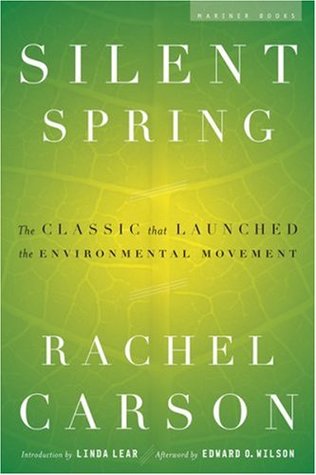
“Why should we tolerate a diet of weak poisons, a home in insipid surroundings, a circle of acquaintances who are not quite our enemies, the noise of motors with just enough relief to prevent insanity? Who would want to live in a world which is just not quite fatal?”
“We stand now where two roads diverge. But unlike the roads in Robert Frost’s familiar poem, they are not equally fair. The road we have long been traveling is deceptively easy, a smooth superhighway on which we progress with great speed, but at its end lies disaster. The other fork of the road — the one less traveled by — offers our last, our only chance to reach a destination that assures the preservation of the earth.”
This is the book that launched the environmental movement in the United States. Rachel Carson addressed the world about the growing crisis of pesticide pollution (specifically DDT). DDT was thinning the eggshells of predatory birds, killing all the chicks. The silence that the title refers to is a world without birds. We owe so much of our understanding about the environment to Rachel Carson and to this book.
The Burning Season: The Murder of Chico Mendes and the Fight for the Amazon Rain Forest
Categories: Ecology, Humans & Nature
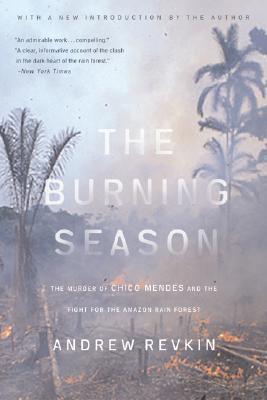
“It became clear that the murder was a microcosm of the larger crime: the unbridled destruction of the last great reservoir of biological diversity on Earth.”
Chico Mendes was a rubber tapper in the Brazilian state of Acre in the remote Amazon Basin. He became a community organizer and successful environmental activist, advocating for reserves of forest where rubber could be grown in agro-forestry practices. He was murdered for his audacity to stand up against the largest forces on earth to ask for the preservation of the Amazon.
The Final Forest: The Battle for the Last Great Trees of the Pacific Northwest
Categories: Ecology, Humans & Nature
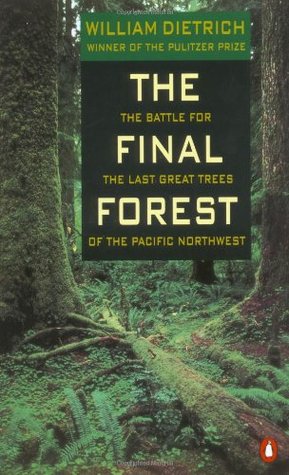
The old-growth trees of America’s Pacific Northwest are the largest in the world. To walk in those forests leaves you speechless at the scale of the natural world. Yet, over 90% of those forests have already been destroyed by logging. This is the story of logging and extraction in those forests, the people who earn their living from the land, the people who spent their lives fighting to save the forests, and the spotted owl that was at the center of the legal decision that brought down the logging industry in the early 1990’s. We hear from remarkably different perspectives about how they want to live in a landscape that they all love.
Collapse
Categories: Climate Change, Ecology, Economics, Humans & Nature

What happens when a society outstrips its natural resources? Jared Diamond, legendary author of Guns, Germs, and Steel, takes a sweeping tour of the world to visit the societies that have collapsed in the distant past from Chaco Canyon to Easter Island to Greenland, and into recent times with the Rwandan genocide. He then analyzes our current state of resource overconsumption in a globalized world. As always, Diamond is incredibly detailed, with insights that cut through the fog of confusion that surrounds our modern predicament.
“Two types of choices seem to me to have been crucial in tipping the outcomes [of the various societies’ histories] towards success or failure: long-term planning and willingness to reconsider core values. On reflection we can also recognize the crucial role of these same two choices for the outcomes of our individual lives.”
“I have often asked myself, “What did the Easter Islander who cut down the last palm tree say while he was doing it?” Like modern loggers, did he shout “Jobs, not trees!”? Or: “Technology will solve our problems, never fear, we’ll find a substitute for wood”? Or: “We don’t have proof that there aren’t palms somewhere else on Easter, we need more research, your proposed ban on logging is premature and driven by fear-mongering”? Similar questions arise for every society that has inadvertently damaged its environment.”
Small Is Beautiful: Economics As If People Mattered
Categories: Culture, Ecology, Economics
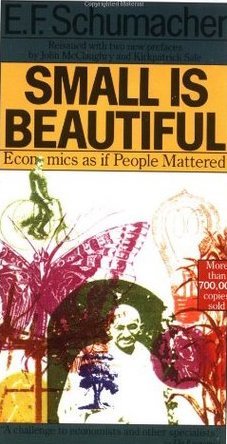
This classic asks a simple question: does our modern economy function in the interest of the average person? The obvious answer is that it does not. Schumacher outlines solutions and different ways of thinking about economics. This book is an antidote to the neoliberal economic policies of the world that have dominated since the time of Reagan and Thatcher, causing untold environmental and cultural destruction.
“Fossil fuels are merely a part of the “natural capital” which we steadfastly insist on treating as expendable, as if it were income, and by no means the most important part. If we squander our fossil fuels, we threaten civilisation; but if we squander the capital represented by living nature around us, we threaten life itself.”
The Limits To Growth
Categories: Climate Change, Ecology, Economics
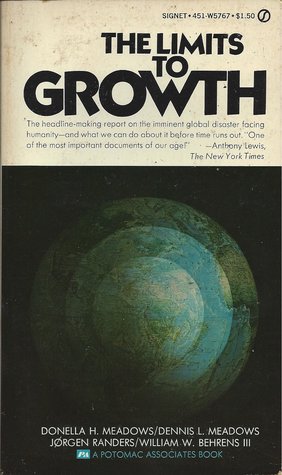
The message of this book still holds today: The earth’s interlocking resources – the global system of nature in which we all live – probably cannot support present rates of economic and population growth much beyond the year 2100, if that long, even with advanced technology. In the summer of 1970, an international team of researchers at the Massachusetts Institute of Technology began a study of the implications of continued worldwide growth. They examined the five basic factors that determine and, in their interactions, ultimately limit growth on this planet-population increase, agricultural production, nonrenewable resource depletion, industrial output, and pollution generation. The MIT team fed data on these five factors into a global computer model and then tested the behavior of the model under several sets of assumptions to determine alternative patterns for mankind’s future. The Limits to Growth is the nontechnical report of their findings. The book contains a message of hope, as well: Humans can create a society in which we can live indefinitely on earth if we impose limits on ourselves and our production of material goods to achieve a state of global equilibrium with population and production in carefully selected balance.
You can download a PDF version of The Limits To Growth from the main author’s website here.
“There are “50 simple things you can do to save the planet.” Buy an energy-efficient car, for one. Recycle your bottles and cans, vote knowledgeably in elections—if you are among those people in the world blessed with cars, bottles, cans, or elections. There are also not-so-simple things to do: Work out your own frugally elegant lifestyle, have at most two children, argue for higher prices on fossil energy (to encourage energy efficiency and stimulate development of renewable energy), work with love and partnership to help one family lift itself out of poverty, find your own “right livelihood,” care well for one piece of land, do whatever you can to oppose systems that oppress people or abuse the earth, run for election yourself.”
“People don’t need enormous cars; they need admiration and respect. They don’t need a constant stream of new clothes; they need to feel that others consider them to be attractive, and they need excitement and variety and beauty. People don’t need electronic entertainment; they need something interesting to occupy their minds and emotions. And so forth. Trying to fill real but nonmaterial needs-for identity, community, self-esteem, challenge, love, joy-with material things is to set up an unquenchable appetite for false solutions to never-satisfied longings. A society that allows itself to admit and articulate its nonmaterial human needs, and to find nonmaterial ways to satisfy them, world require much lower material and energy throughputs and would provide much higher levels of human fulfillment.”
Braiding Sweetgrass
Categories: Decolonization, Ecology, Humans & Nature, Top Picks
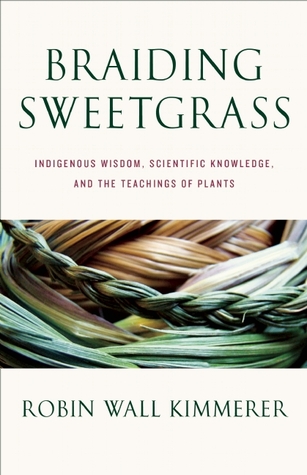
“On Mondays, Wednesdays, and Fridays at 9:35 a.m., I am usually in a lecture hall at the university, expounding about botany and ecology—trying, in short, to explain to my students how Skywoman’s gardens, known by some as “global ecosystems,” function. One otherwise unremarkable morning I gave the students in my General Ecology class a survey. Among other things, they were asked to rate their understanding of the negative interactions between humans and the environment. Nearly every one of the two hundred students said confidently that humans and nature are a bad mix. These were third-year students who had selected a career in environmental protection, so the response was, in a way, not very surprising. They were well schooled in the mechanics of climate change, toxins in the land and water, and the crisis of habitat loss. Later in the survey, they were asked to rate their knowledge of positive interactions between people and land. The median response was “none.”
I was stunned. How is it possible that in twenty years of education they cannot think of any beneficial relationships between people and the environment? Perhaps the negative examples they see every day— brownfields, factory farms, suburban sprawl—truncated their ability to see some good between humans and the earth. As the land becomes impoverished, so too does the scope of their vision.”
Braiding Sweetgrass is a beautiful journey through our personal and cultural relationships with the natural world. Robin Wall Kimmerer writes from the dual perspectives of a Native American woman and an ecology professor, outlining the intersection between science and traditional ways of knowing the Earth. She writes to share a vision—how we can begin to form beneficial relationships with the natural world and move beyond a model of damage control.
The Man Who Planted Trees
Categories: Culture, Ecology, Humans & Nature, Top Picks
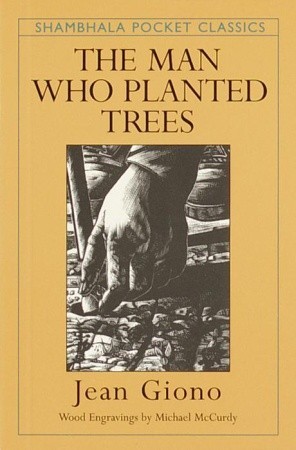
“The oaks of 1910 were then ten years old and taller than either of us. It was an impressive spectacle. I was literally speechless and, as he did not talk, we spent, the whole day walking in silence through his forest. In three sections, it measured eleven kilometers in length and three kilometers at its greatest width. When you remembered that all this had sprung from the hands and the soul of this one man, without technical resources, you understand that men could be as effectual as God in other realms than that of destruction.”
This gem is among our favorite stories: a simple allegory about the efforts of one man to change the world around him. It’s wonderfully written and just a fifteen minute read. This version, the story read aloud over an animated illustration, won an academy award for short films in 1987, and we highly recommend it. You can find Jeff’s transcription of this version here.
A Sand County Almanac
Categories: Culture, Ecology, Humans & Nature
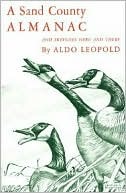
“Cease being intimidated by the argument that a right action is impossible because it does not yield maximum profits, or that a wrong action is to be condoned because it pays.”
“Conservation is getting nowhere because it is incomprehensible with our Abrahamic concept of land. We abuse land because we regard it as a commodity belonging to us. When we see land as a community to which we belong, we may begin to use it with love and respect. There is no other way for land to survive the impact of the mechanized man, nor for us to reap from it the esthetic harvest it is capable, under science, of contributing to culture. That land is a community is the basic concept of ecology, but that land is to be loved and respected is an extension of ethics. That land yields a cultural harvest is a fact long known, but latterly often forgotten…perhaps such a shift of values can be achieved by reappraising things unnatural, tame and confined in terms of things natural, wild, and free.”
In a series of essays in three parts, Leopold describes the “delights and dilemmas of one who cannot [live without wild things].” As a part-time farmer who works to make a home out of of an overexploited and abandoned farm in Sand County, Wisconsin, he is intimate with those delights and dilemmas. In part one, he sharply, lovingly observes the farm and its minute changes throughout the seasons: from the geese he admires to the partridge he hunts. In part two, he describes conservation issues affecting a variety of places scattered throughout North America. In part three, he expresses his grief at America’s current (at the time of writing) relationship with nature and what might be done to restore a healthy, compassionate relationship and land ethic. Throughout the book are lovely illustrations drawn by Charles W. Schultz.